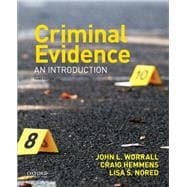Criminal Evidence: An Introduction, Third Edition, provides comprehensive and applied coverage of the rules of evidence, along with numerous case excerpts that clearly illustrate those rules. Using engaging, straightforward language, authors John L. Worrall, Craig Hemmens, and Lisa S. Nored offer an invaluable and innovative resource for both students and instructors.
Concentrating on the Federal Rules of Evidence, this distinctive text presents in-depth yet accessible coverage of evidentiary law in fourteen succinct chapters. To draw students into this complex subject, the authors explain criminal evidence through a unique blend of text and case excerpts; throughout, these excerpts illuminate the rules in useful, fascinating, and often unusual examples.








